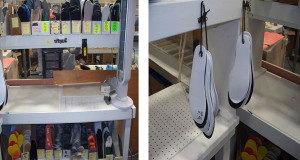CONFERENCE COVERAGE: Orthotics Technology Forum 2013
By Emily Delzell
The need to replace entrenched processes and thinking with fluid, fast-moving orthotic design and manufacture that minimizes errors and maximizes resources was highlighted by several speakers at the Orthotics Technology Forum, including Jarret Eschenburg, CPed, director of operations at Coral Springs, FL-based SureFit, a subsidiary of Hanger.
Eschenburg made a distinction between simply “having technology” versus “using technology” in an optimal way—one that facilitates continual change and improvements in orthotic fabrication and results in an enhanced bottom line for lab owners.

From clutter to clean: The tracing library before and after SureFit’s process-flow kaizen. (Photos courtesy of Jarret Eschenburg, CPed.)
This effort to make the most of expensive technology—SureFit invested in CAD-CAM in 2005, adding two mills to its lab—resulted in a reengineering process that streamlined the fabrication workflow and reduced workforce from 30 to 17 and turn-around times from 14 days to seven.
With new technology in place, Eschenburg continued his quest for kaizen, a Japanese term for continuous improvement, by embracing lean manufacturing, defined as “a manufacturing philosophy that shortens the time line between the customer order and the product shipment by eliminating waste using continuous improvement techniques.”
The first step to getting “lean,” he said, is standardizing work. A review of SureFit’s lab processes showed each employee did the same task slightly differently, from the orthotic gluers and grinders to the certified pedorthists who analyzed orders. The review also identified sources of waste, Eschenburg said, which in orthotic fabrication often involve quality issues, such as reworking orders, and workstation delays that cause bottlenecks.
“Wait times between processes eat up time. You may say it takes only about 45 minutes to actually make an orthotic, when in reality, it takes all day,” he said.
“Key lean concepts are using your current resources, and changing from the bottom up, not from the top down. It’s hands-on workers who really know what the issues are and can best suggest ways to improve,” he said. “Once processes are standardized you can implement crosstraining in which, ideally, every worker can do every job.”
Eschenburg next focused his continuous change efforts on three areas in orthotic manufacturing: reducing distances traveled by reducing the lab’s footprint, standardizing jobs to increase speed, and setting up a pull system to lower WIP (work in process) in the target area (postmill to grind finish).
“When orders get backed up you have increased WIP and work time. At this time we had a WIP of 400 orders—when I said we were aiming for 20 we almost had a revolution. We had a two-day turnaround in that area; we wanted it done that same day,” he said.
Every employee took part in the brainstorming that resulted in a new floor plan and a standard workflow for every operator—about 175 action items in all.
It took about three months to identify and implement changes, but the end results were worth it, Eschenburg said. SureFit reduced its lab footprint by 30% and achieved other efficiencies, such as setting up a standardized gluing process and simplifying tracing (see figure above).
“I regard SureFit’s progress merely as a means to do more. It’s an indication that we have reached a place where we might begin to improve again,” Eschenburg said.










This is interesting. Does anyone know the name of the consulting firm who helped turn this around?